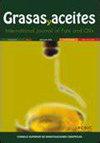GC/MS quantification of individual fatty acids of selected green leafy vegetable foliage and their biodiesel attributes
IF 1.1
4区 农林科学
Q4 CHEMISTRY, APPLIED
引用次数: 1
Abstract
The current demand for edible vegetable oil is increasing worldwide, and the development of new sources of high-quality vegetable edible oil is an essential task. There is also a huge demand for biodiesel in domestic and industrial applications, and foliage oils could be a good source for diesel applications. The current study aimed at the identification and quantification of fatty acids from commonly consumed green leafy vegetables (GLVs) viz., Hibiscus cannabinus, Hibiscus sabdariffa, Basella alba, Basella rubra, and Rumex vesicarius and to calculate the biodiesel attributes of the oil. The total oil content was ascertained as the highest in R. vesicarius foliage (3.91 ± 0.27 g/100 g dry leaf powder). GC/MS chromatographic investigation identified 9,12,15-octadecatrienoic acid as a significant compound followed by hexadecanoic acid. In Hibiscus spp. C18:3 (49.3 µmol % and 50.4 µmol %) was recorded to be the most noteworthy followed by C16:0 (23.2 µmol % and 21 µmol %) in H. cannabinus and H. sabdariffa, respectively. The GLVs foliage-fatty acid biodiesel attributes were additionally assessed through an empirical formula. Consequently, the overall examined results will be helpful for the investigation of these oils as vegetable oil for human consumption and biodiesel applications.选定绿叶蔬菜叶片中单个脂肪酸的GC/MS定量及其生物柴油特性
目前,全球对食用植物油的需求正在增加,开发优质植物食用油的新来源是一项重要任务。在国内和工业应用中对生物柴油也有巨大的需求,叶油可能是柴油应用的良好来源。目前的研究旨在识别和定量常见绿叶蔬菜(GLV)中的脂肪酸,即木槿、木槿花、白槿、红槿和酸模,并计算该油的生物柴油特性。总含油量以R最高。水疱叶(3.91±0.27g/100g干叶粉)。GC/MS色谱研究表明,9,12,15-十八碳三烯酸是一种重要的化合物,其次是十六碳酸。在木槿属中。C18:3(49.3µmol%和50.4µmol%)是最值得注意的。cannabinus和H。sabdariffa。通过经验公式对GLVs树叶脂肪酸生物柴油的特性进行了额外评估。因此,总体检测结果将有助于研究这些油作为人类食用的植物油和生物柴油的应用。
本文章由计算机程序翻译,如有差异,请以英文原文为准。
求助全文
约1分钟内获得全文
求助全文
来源期刊

Grasas y Aceites
工程技术-食品科技
CiteScore
2.50
自引率
0.00%
发文量
50
审稿时长
3 months
期刊介绍:
Grasas y Aceites is a peer-reviewed journal devoted to the publication of original articles concerning the broad field of lipids, especially edible fats and oils from different origins, including non acyl lipids from microbial origin relevant to the food industry. It publishes full research articles, research notes, reviews as well as information on references, patents, and books.
Grasas y Aceites publishes original articles on basic or practical research, as well as review articles on lipid related topics in food science and technology, biology, (bio)chemistry, medical science, nutrition, (bio)technology, processing and engineering. Topics at the interface of basic research and applications are encouraged. Manuscripts related to by-products from the oil industry and the handling and treatment of the wastewaters are also welcomed.
Topics of special interest to Grasas y Aceites are:
-Lipid analysis, including sensory analysis
-Oleochemistry, including lipase modified lipids
-Biochemistry and molecular biology of lipids, including genetically modified oil crops and micro-organisms
-Lipids in health and disease, including functional foods and clinical studies
-Technical aspects of oil extraction and refining
-Processing and storage of oleaginous fruit, especially olive pickling
-Agricultural practices in oil crops, when affecting oil yield or quality
 求助内容:
求助内容: 应助结果提醒方式:
应助结果提醒方式:


